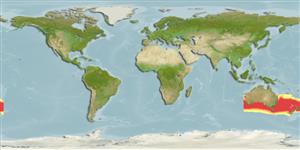Environment: milieu / climate zone / depth range / distribution range
Écologie
marin; saumâtre; profondeur 22 - 500 m (Ref. 58489), usually ? - 150 m (Ref. 9072). Subtropical; 23°S - 50°S, 112°E - 176°W
Southwest Pacific: Australia and New Zealand waters. Two subpopulations probably exist in the Great Australian Bight and southeastern Australia, respectively, and two species or subspecies in the southeastern group (Ref. 7456).
Length at first maturity / Taille / Poids / Âge
Maturity: Lm 20.0 range ? - ? cm
Max length : 50.0 cm SL mâle / non sexé; (Ref. 33839); common length : 35.0 cm TL mâle / non sexé; (Ref. 9258); âge max. reporté: 25 années (Ref. 9072)
Épines dorsales (Total) : 9; Rayons mous dorsaux (Total) : 27 - 33; Épines anales: 3; Rayons mous anaux: 22 - 29; Vertèbres: 24. Adults are elongate and compressed, and have a primary lateral line with 67-81 scutes, a secondary lateral line reaching to dorsal-fin ray 2, and a yellow caudal fin.
Adults occur in coastal waters, including estuaries (Ref. 9563), mostly in waters shallower than 150 m and warmer than 13°C (Ref. 9072). Commonly found on the bottom, in midwater and occasionally at the surface (Ref. 9258), in large schools (Ref. 33616). Adults are generally found over offshore rocky reefs, while juveniles are generally found in shallow, soft substrate areas (Ref. 6390). Utilized fresh, smoked, canned and frozen; can be fried, broiled and baked (Ref. 9988).
Paxton, J.R., D.F. Hoese, G.R. Allen and J.E. Hanley, 1989. Pisces. Petromyzontidae to Carangidae. Zoological Catalogue of Australia, Vol. 7. Australian Government Publishing Service, Canberra, 665 p. (Ref. 7300)
Statut dans la liste rouge de l'IUCN (Ref. 130435)
Menace pour l'homme
Harmless
Utilisations par l'homme
Pêcheries: commercial; pêche sportive: oui; appât: usually
Outils
Articles particuliers
Télécharger en XML
Sources Internet
Estimates based on models
Preferred temperature (Ref.
123201): 13.1 - 21.2, mean 15.3 °C (based on 70 cells).
Phylogenetic diversity index (Ref.
82804): PD
50 = 0.5001 [Uniqueness, from 0.5 = low to 2.0 = high].
Bayesian length-weight: a=0.01778 (0.01025 - 0.03084), b=2.98 (2.84 - 3.12), in cm total length, based on LWR estimates for this species & Genus-body shape (Ref.
93245).
Niveau trophique (Ref.
69278): 3.2 ±0.40 se; based on food items.
Generation time: 3.7 ( na - na) years. Estimated as median ln(3)/K based on 2
growth studies.
Résilience (Ref.
120179): Milieu, temps minimum de doublement de population : 1,4 à 4,4 années (K=0.30; tm=3-4; tmax=25).
Fishing Vulnerability (Ref.
59153): Moderate vulnerability (37 of 100).
Nutrients (Ref.
124155): Calcium = 263 [161, 434] mg/100g; Iron = 3.76 [2.23, 6.42] mg/100g; Protein = 19.8 [19.0, 20.5] %; Omega3 = 0.383 [0.249, 0.578] g/100g; Selenium = 26.8 [14.7, 49.8] μg/100g; VitaminA = 8.05 [2.13, 29.13] μg/100g; Zinc = 2.37 [1.72, 3.33] mg/100g (wet weight);
